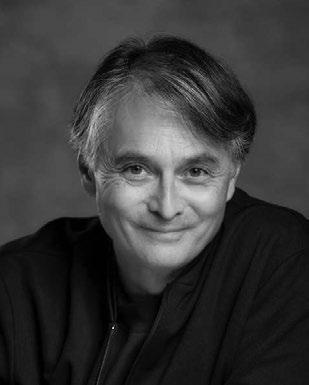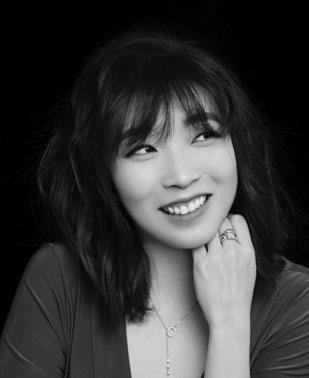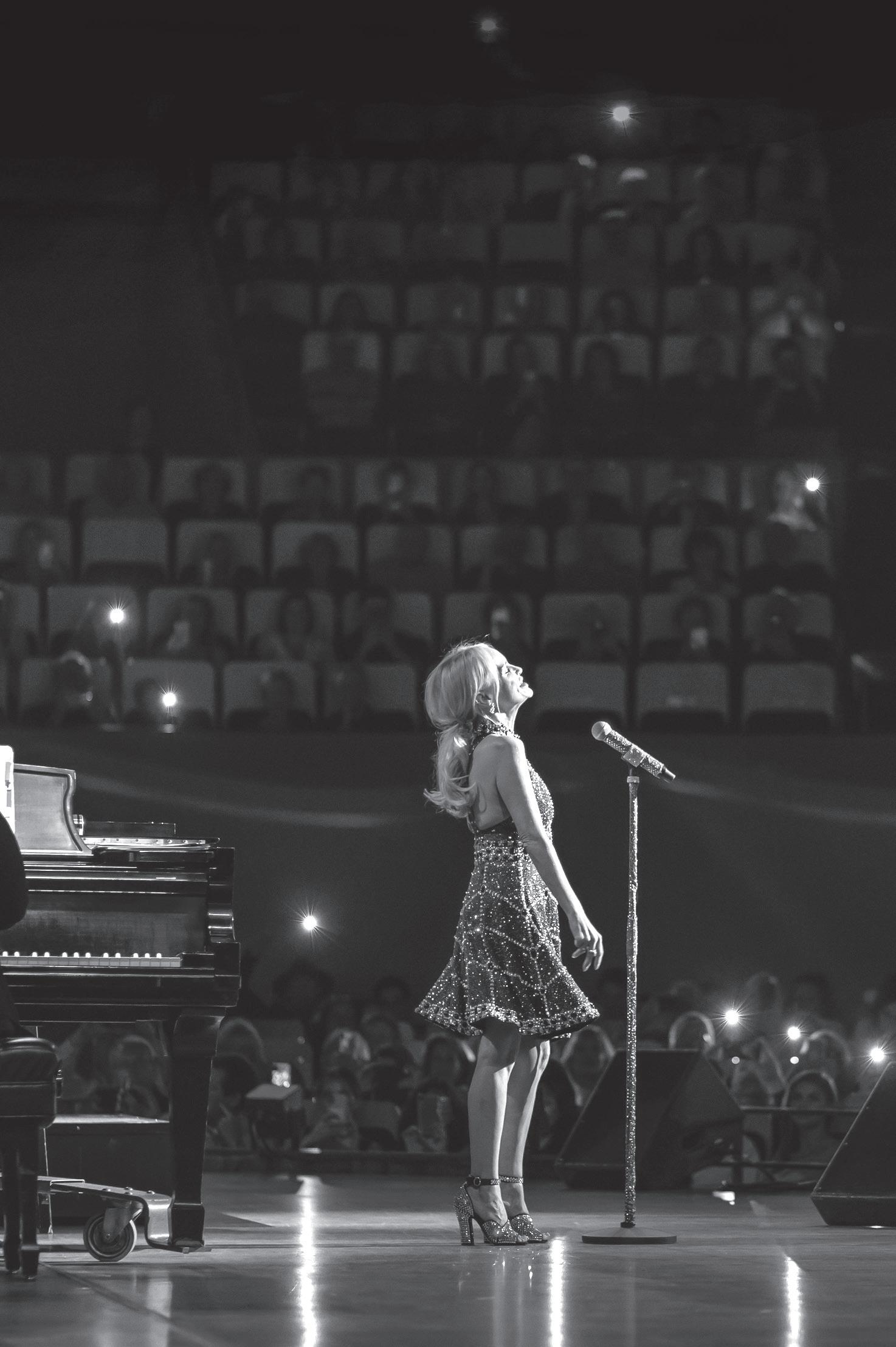CLASSICS 2021/22
R. STRAUSS CONDUCTED BY JUN MÄRKL
JUN MÄRKL, conductor CLAIRE HUANGCI, piano
Friday, April 29, 2022 at 7:30pm
Saturday, April 30, 2022 at 7:30pm
Sunday, May 1, 2022 at 1:00pm
Boettcher Concert Hall
BEETHOVEN
Piano Concerto No. 3 in C minor, Op. 37
Allegro con brio
Largo
Rondo: Allegro
— INTERMISSION —
R. STRAUSS Don Juan, Op. 20
R. STRAUSS Till Eulenspiegel’s Merry Pranks, Op. 28
CONCERT RUN TIME IS APPROXIMATELY 1 HOUR AND 34 MINUTES WITH A 20 MINUTE INTERMISSION
FIRST TIME TO THE SYMPHONY? SEE PAGE 7 OF THIS PROGRAM FOR FAQ’S TO MAKE YOUR EXPERIENCE GREAT!

Friday’s concert is dedicated to Kenneth and Zoe Barley saturday’s concert is dedicated to heidi Burose sunday’s concert is dedicated to sharon Menard
PROUDLY SUPPORTED BY
SOUNDINGS 2021/22 PROGRAM I
2021/22 SEASON
PRESENTING SPONSOR:
CLASSICS BIOGRAPHIES
JUN MÄRKL, conductor
Jun Märkl is a highly-respected interpreter of both symphonic and operatic Germanic repertoire, and also for his idiomatic explorations of the French impressionists. His long-standing relationships at the state operas of Vienna, Berlin, Munich and Semperoper Dresden have been complemented by his directorships of the Nationaltheater Mannheim (1994-2000), Orchestre National de Lyon (2005-11) , MDR Symphony Orchestra Leipzig (2007-2012) and the Basque National Orchestra (2014-17).
He is holding positions with the Malaysia Philharmonic Orchestra as Music Director since 2021, National Symphony oRchestra of Taiwan as Music Director from 2022, Artistic Advisor of Indianapolis Symphony Orchestra, Principal Guest Conductor of Resident Orkest Den Haag and Oregon Symphony Orchestra.
He appeared with many of the world’s leading orchestras, among others the Bavarian Radio Symphony, Munich, Hamburg, Oslo philharmonics, the Cleveland, Boston, Chicago, Philadelphia, Montreal, Melbourne , Sydney orchestras, NHK Symphony Orchestra Tokyo, Tonhalle Orchester Zürich, Orchestre de Paris.
Jun Märkl was a regular guest at the state operas of Vienna, Munich, Berlin and Semperoper Dresden, and was permanent conductor of the Bavarian State Opera until 2006. He made his Royal Opera House Covent Garden debut with Götterdämmerung in 1996 and with Il Trovatore at the Metropolitan Opera in 1998. He conducted complete Ring cycles at the Deutsche Oper Berlin and at the New National Theatre in Tokyo 2001-2004, and toured Japan with Semperoper Dresden and Wiener Staatsoper.

Jun Märkl has an extensive discography - among the more than 50 CDs, he has recorded the complete Schumann symphonies with the NHK Symphony, Mendelssohn and Wagner with the MDR, Ravel , Messiaen and a 9 CD recording of Debussy with Lyon which lead to honoration by the French Ministry of Culture in 2012 with the “Chevalier de l’Ordre des Arts et des Lettres.” Recently he recorded 3 CDs with works of Toshio Hosokawa and 4 CDs of rare works by Saint Saens.
Born in Munich, Märkl’s father was a distinguished concertmaster and his mother a solo pianist. Jun Märkl studied at the Musikhochschule in Hannover, with Sergiu Celibidache in Munich and Gustav Meier in Michigan. In 1986, he won the conducting competition of the Deutsche Musikrat and a year later won a scholarship from the Boston Symphony Orchestra to study at Tanglewood with Leonard Bernstein and Seiji Ozawa.
He is also very dedicated to work with young musicians: regularly he worked as Principal Conductor at the Pacific Music Festival in Sapporo, the Aspen Music Festival, Colorado and he teaches as Guest Professor at the Kunitachi College of Music Tokyo.
PROGRAM II COLORADOSYMPHONY.ORG
CLASSICS BIOGRAPHIES
CLAIRE HUANGCI, piano
The young American pianist Claire Huangci, winner of the first prize and the Mozart prize at the 2018 Geza Anda Competition, continuously captivates audiences with her “radiant virtuosity, artistic sensitivity, keen interactive sense and subtle auditory dramaturgy” (Salzburger Nachrichten). With an irrepressible curiosity and penchant for unusual repertoire, she proves her versatility with a wide range in repertoire spanning from Bach and Scarlatti, to Bernstein, Gulda, and Corigliano.

In solo recitals and with international orchestras, Claire has appeared in some of the most prestigious halls such as Carnegie Hall, Suntory Hall Tokyo, NCPA Beijing, Paris Philharmonie, Munich Gasteig, Leipzig Gewandhaus, Hamburg Elbphilharmonie, Salzburg Festspielhaus, and the Budapest Franc Liszt Akademie. She is a welcome guest in renowned festivals including Lucerne Festival, Verbier Festival, Schleswig Holstein Musik Festival, Rheingau Musik Festival and Klavier Festival Ruhr. Mozarteumorchester Salzburg, Stuttgart Radio Symphony Orchestra, Tonhalle-Orchester Zurich, ORF Radio Orchester Vienna, Vancouver Symphony, and China Philharmonic Orchestra, together with Sir Roger Norrington, Howard Griffiths, Eva Ollikainen, Mario Venzago, Cornelius Meister, and Elim Chan are among her esteemed musical partners.
For an intense start of the 2020/21 season, Claire paid homage to Beethoven’s anniversary with a compelling interpretation of his Pastorale symphony arranged for solo piano by Franz Liszt, with concerts at the Klavier-Festival Ruhr and the Rheingau Musik Festival, where her recital was recorded for T-Mobile‘s streaming platform MagentaMusik 360. After appearances as a piano duo with Alexei Volodin at the Hamburg Elbphilharmonie and the release of a new album with her Trio Machiavelli, a major highlight is her Fall 2020 recital tour at the main halls of Berlin Philharmonie, and Hamburg Elbphilharmonie. Later in the season, a further exciting debut takes place in the “Great Performers Series“ at New York‘s Lincoln Center. Among her orchestra engagements are dates with the Deutsche Radiophilharmonie Saarbrücken, Museumsorchester Frankfurt, Basel Chamber Orchestra and the Slovak Philharmonic Orchestra. With the Nordic Chamber Orchestra, she will direct concertos of Mozart and Chopin from the keyboard.
Claire Huangci began her international career at the age of nine with concert performances and competition successes. After studying with Eleanor Sokoloff and Gary Graffman at the Curtis Institute of Music in Philadelphia, she moved to Germany in 2007 for further studies with Arie Vardi at the Hannover Musikhochschule, completing them with honors in 2016. Early in her artistic career, she stood out as an expressive interpreter of Chopin, winning first prizes at the Chopin competitions in Darmstadt and Miami in 2009 and 2010. She was also the youngest participant to receive second prize at the International ARD Music Competition in 2011.
In summer of 2020, her first chamber music album was released with Trio Machiavelli, whose interpretations of Ravel trio and Chausson piano quartet proved „a wholly exhilarating debut (…) splendidly transparent, and always expressive.“ (BR Klassik).
SOUNDINGS 2021/22 PROGRAM III
CLASSICS BIOGRAPHIES
LUDWIG VAN BEETHOVEN (1770-1827)
Piano Concerto No. 3 in C minor, Op. 374
Ludwig van Beethoven was born on December 16, 1770 in Bonn, and died on March 26, 1827 in Vienna. Though the Third Concerto was largely composed in 1800, the earliest sketches for it date from 1797, and the finishing touches were not applied until 1803. It was premiered at Beethoven’s concert in the Theater-an-der-Wien, Vienna, on April 4, 1803. The score calls for woodwinds, horns and trumpets in pairs, timpani and strings. Duration is about 34 minutes. The last performance by the orchestra was November 30-December 2, 2018 with Hans Graf conducting and Inon Barnatan on piano.
By 1803, Emanuel Schickaneder, the colorful character who figured so prominently in the closing pages of Mozart’s life as the librettist and producer of The Magic Flute, had taken over the management of Vienna’s Theater-an-der-Wien. His house was locked in a fierce competitive battle with the court-subsidized Kärtnertortheater, run by Baron Peter von Braun. When von Braun hired the distinguished Luigi Cherubini as resident composer, Schickaneder felt obliged to counter with his own music master, and he approached Beethoven with an offer. Beethoven, who had felt the need to write for the stage for some time, accepted gladly — especially since the job carried free lodgings in the theater as part of the compensation. He and Schickaneder dutifully plowed through a small library of possibilities for an operatic subject, but none inspired Beethoven until he took up work on Fidelio late in 1803. In the meantime, Beethoven took advantage of his theatrical connection to put some of his instrumental works on display. Since opera was forbidden in Catholic countries during Lent at that time, the Theater-an-der-Wien was available for concerts in the early spring, and Beethoven scheduled such an event during April 1803. It had been fully three years since he last presented a concert entirely of his own orchestral music, and he had several scores that were awaiting their first presentations, including the Second Symphony, the oratorio Christ on the Mount of Olives and the Third Piano Concerto. He programmed all of these, and, for good measure, tossed in the First Symphony, which had been premiered at his concert three years earlier.
The Third Concerto’s first movement opens with the longest introductory orchestral tutti in Beethoven’s concertos. The strings in unison present the main theme; the lyrical second theme is sung by violins and clarinet in a contrasting major mode. The closely reasoned development section grows inexorably from thematic fragments heard in the exposition. The recapitulation begins with a forceful restatement of the main theme by the full orchestra. The second movement is a nocturne of tender sentiments and quiet moods. Though analysis reveals its form to be a three-part structure (A–B–A), it is in spirit simply an extended song — a marvelous juxtaposition of hymnal tranquility and sensuous operatic love scene. The traditional, Classical rondo was a form of simple, high spirits meant to send the audience away in a bubbling mood. Mozart, in his incomparable late concertos, had begun to explore the emotional depth possible with the rondo, and in the Third Concerto, Beethoven continued that search. He incorporated elements of sonata design into the finale to lend it additional weight, even inserting a fugal passage in the second episode. Only in the closing pages is the dark world of C minor abandoned for a vivacious romp through C major to close this wonderful work of Beethoven’s early maturity.
PROGRAM IV COLORADOSYMPHONY.ORG
CLASSICS BIOGRAPHIES
RICHARD STRAUSS (1864-1949) Don Juan, Op. 20
Richard Strauss was born on June 11, 1864 in Munich, and died on September 9, 1949 in GarmischPartenkirchen. He composed Don Juan in 1888 and conducted the Weimar Hoftheater Orchestra in the work’s premiere on November 11, 1889 in Weimar. The score calls for piccolo, three flutes, two oboes, English horn, two clarinets, two bassoons, contrabassoon, four horns, three trumpets, three trombones, tuba, timpani, percussion, harp and strings. Duration is about 17 minutes. The orchestra last performed Don Juan October 23-24, 2015. Andrew Litton was the conductor.
It was in the 1630 drama El Burlador de Sevilla (“The Seducer of Seville”) by the Spanish playwright Tirso de Molina that the fantastic character of Don Juan first strutted upon the world’s stages. Tirso based his play on folk legends that were at least a century old in his day, and whose roots undoubtedly extend deeply into some Jungian archetype of masculine virility shared, from complementary viewpoints, by men and women alike. Don Juan found frequent literary representations thereafter, notably in works by Molière, Dumas, Byron, Espronceda, de Musset, Zorrilla and Shaw. A story of such intense passion was bound to inspire composers as well as men of letters, and Gluck, Delibes, Alfano, Dargomyzhsky and half a dozen others wrote pieces based on the character and his exploits. The most famous treatment of the tale is, of course, Mozart’s Don Giovanni, and it was through that opera that Richard Strauss first became acquainted with the Spanish Lothario. In June 1885, Strauss attended a production of Paul Heyse’s play Don Juans Ende with his mentor, Hans von Bülow, and the drama and its subject, building on the influence of Mozart’s masterpiece, made a powerful impression on the young composer.
Strauss started sketching his own Don Juan late in 1887, soon after he had met Pauline de Ahna in August. Pauline, a singer of considerable talent, got on splendidly with Strauss, and they were soon in love and married. The impassioned love themes of Don Juan were written under the spell of this romance. (The couple remained apparently happily married for the rest of their lives, though Pauline was a renowned nag. Gustav and Alma Mahler would cross the street to avoid meeting her. In 1904, his torch still glowing, Richard wrote his Domestic Symphony — that grandiloquent ode to life among the pots and pans — as a tribute to his familial bliss with Pauline.) For the program of his tone poem, Strauss went not to da Ponte or the Spanish authors, but to the 19th-century Hungarian poet Nicolaus Lenau. Lenau, born in 1802, was possessed by a blazing romantic spirit fueled in part by a hopeless love for the wife of a friend. In a fit of idealism in 1832, he came to America and settled on a homestead in Ohio for a few months. Disappointed with the New World, he returned to Europe, where he produced an epic on the Faust legend in 1836, and then undertook a poetic drama based on Don Juan. Lenau left this latter work unfinished in 1844 when he lost his mind and was admitted to an asylum, where he died six years later. Lenau’s Don Juan was not a rakish extrovert but rather a vain, sensual idealist. In the author’s words, “My Don Juan is no hotblooded man, eternally pursuing women. It is the longing in him to find a woman who is to him womanhood incarnate, and to enjoy in the one all the women on earth whom he cannot as individuals possess. Because he does not find her, although he reels from one to another, at last Disgust seizes hold of him, and this Disgust is the Devil that fetches him.” In Lenau’s
SOUNDINGS 2021/22 PROGRAM V
CLASSICS PROGRAM NOTES
version, Don Juan meets his death in a sword duel with the father of one of the women he has seduced. Disillusioned and empty, ready for death, he drops his guard and welcomes his fate.
Strauss’ tone poem captures the feverish emotion and charged sensuality of Lenau’s drama, but other than three abstruse excerpts from Lenau’s poem that appear in the score, the composer never gave a specific program for Don Juan. (Strauss learned early that he could get more publicity by letting critics and commentators contend over such details.) The body of the work comprises themes associated with the lover and his conquests. The vigorous opening strain and a stentorian melody majestically proclaimed by the horns near the mid-point of the work belong to Don Juan. The music depicting the women in his life is variously coquettish, passionate and ravishing. (Norman Del Mar called the beautiful oboe melody “one of the greatest lovesongs in all music”). In the closing pages, an enormous crescendo is suddenly broken off by a long silence. A quivering chill comes over the music. A dissonant note on the trumpets marks the fatal thrust. Quietly, without hope of redemption, the libertine dies.
RICHARD STRAUSS
Till Eulenspiegel’s Merry Pranks, Op. 28 Strauss composed Till Eulenspiegel in 1894-1895. It was premiered in Cologne under the baton of Franz Wüllner on November 5, 1895. The score calls for piccolo, three flutes, three oboes, English horn, small clarinet in D, two clarinets in B-flat, bass clarinet, three bassoons, contrabassoon, four horns, three trumpets, three trombones, tuba, timpani, percussion and strings. Duration is about 15 minutes. The last performance by the orchestra was October 5-7, 2012 with Cralos Miguel Prieto conducting.
The “Till Eulenspiegel” from which Strauss’ tone poem sprang was a well-known character of German folklore, a “rude mechanical” born in Brunswick in 1283, according to the account of 1515 by a Franciscan monk, Thomas Murner. So popular were the tales of Till that they were soon translated into a half dozen languages, including English, and fully twenty editions of his adventures had been published in French by the beginning of the 18th century. Olin Downes wrote of this impish character, “Till, they say, was a wandering mechanic who lived by his wits, turning up in every town and city. He made himself out to be whatever the situation required — butcher, baker, wheelwright, joiner, monk, or learned metaphysician. He was a lord of misrule, a liar and villain, whose joy it was to plague honest folk and play foul jests upon them. He pillaged the rich, but often helped the poor.... For Till is freedom and fantasy; his is the gallant, mocking warfare of the One against the Many and the tyranny of accepted things. He is Puck and Rabelais, and [he inspired] quicksilver in Strauss’ music.”
PROGRAM VI COLORADOSYMPHONY.ORG
“Eulenspiegel” in German means “owl-mirror,” and it is generally agreed that the name of this legendary rascal, who both embodies and exploits human foibles, alludes to a German proverb: “Man sees his own faults as little as an owl recognizes his ugliness by looking into a mirror.” When asked to elucidate his music, Strauss wrote to Franz Wüllner, the conductor of the premiere, “By way of helping listeners to a better understanding, it seems sufficient to point out the two Eulenspiegel motives, which, in the most manifold disguises, moods and situations, pervade the whole up to the catastrophe, when, after he has been condemned to death, Till is strung up to the gibbet. For the rest, let them guess at the musical joke which the Rogue has offered them.” The two motives Strauss mentioned occur immediately at the beginning of the work — a “once upon a time” phrase played by the strings, and a bounding horn theme. Strauss, a master of thematic manipulation, spun most of the melodic threads of Till from these two motives. Unlike the historical Till, who reportedly died in bed of the plague, Strauss sentenced his scoundrel to swing for his crimes amid threatening rolls on the drums and great blasts from the trombones. The closing pages, however, revive the impish specter of the physically departed Till, as if to say that his insouciant spirit remains always evergreen.







SOUNDINGS 2021/22 PROGRAM VII
Subscribe Today! 2022/23 Season coloradosymphony.org 303.623.7876
©2021 Dr. Richard E. Rodda
CLASSICS PROGRAM NOTES
An Evening with Kristin Chenoweth and the Colorado Symphony

AUG 12 | FRI 7:30
Boettcher Concert Hall
COLORADOSYMPHONY.ORG





